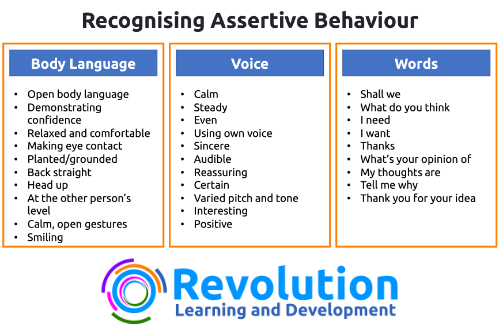About Being Assertive
What is assertiveness? Assertiveness is something that we probably all want to be a bit more of. The fact that 100’s of people each year take our assertiveness skills course backs this up.
What is really interesting is that although people want to be more of it – it’s amazing how many people don’t actually understand what it is they want to be more of.
In other words, many of us don’t actually know what assertiveness is and what it means to be it.
In fact, when people describe assertiveness, more often enough, they are actually describing aggression.
‘I want to be able to tell people what to do’, ‘I want to be stronger with people and get my message heard’, and ‘I want to be listened to by other people’ are some of the things we hear. But, whilst they may be seen as assertive terms or a really good idea of assertiveness, they are probably bordering on aggression.
What is Assertiveness?
So, to the question of What is assertiveness. Assertiveness is described as the “Art of Confident Communication”. It’s a method of communication whereby other people who see the communication have confidence in the person and the message being delivered.
A great definition of assertiveness is ‘confident and direct when dealing with others’.
Let’s break this down:
Confident – the ability to deliver a message with confidence where the people receiving the communication have confidence in the person and the message being delivered. It sounds like it’s the right thing to do.
Direct – Not going from London to Bristol via Newcastle! In other words, it’s getting to the point and not adding unnecessary content to dress up the message, as this can weaken the message or the message gets lost. It’s delivering the message in the most direct way.
Ensuring that assertiveness isn’t confused with aggression is the key to the skill. You may get the directness right, but if the communication style is wrong, then it can still come across as aggressive.
One important thing to understand is that assertiveness isn’t natural. Don’t get me wrong; we may describe other people who are naturally assertive. It is probably more likely that we look at them as being confident and not necessarily assertive.
What Does Assertiveness Look Like?
This means that assertiveness that being assertive is being:
- Calm
- Controlled
- Direct
- Conscious
- Respectful
A term we often use in our assertiveness skills training courses is ‘engaging your brain’. This means that to be assertive, you have to think about being assertive and not just expecting it to happen all by itself.
If we are not self-aware and thinking about our actions, then we are not being truly assertive.
It’s impossible to be assertive always – for two reasons. Reason one is that if you have to think about being assertive, you will always think about being assertive. This will quickly lead to burnout due to the amount of conscious energy required to be assertive.
Secondly, if people around you become used to your assertiveness, you will have to use a different tactic to get the things you want. This probably means you become more aggressive than assertive.
Assertive Communication
Being assertive requires control of 3 things:
- Body Language
- Tone of Voice
- Words/Language

Assertive Body Language
Assertive people are described as using open and confident body language. There is a risk here, though. If you have to force this behaviour on yourself, it can come across as being forced, uncomfortable, and therefore not confident.
Assertive Voice
Calm tones, not shouting or even raising the voice. Assertive people tend to communicate using their current tone of voice.
Assertive Words/Language
Positive language and using questions to understand the other person’s or party’s point of view. Assertive people are also known to be empathetic and use statements to this effect.
Assertive people want to understand other people’s points of view before letting others know their own. This allows for a more considered response and allows the other person to think that you have an interest in their position. This goes a long way to building better relationships and lessens your likelihood of being seen as aggressive.
Being assertive and gaining control are learnt skills and not something we do naturally. Assertiveness is about positive action and not a negative reaction. Assertiveness is also about telling people what you want, telling people how you feel while protecting your own dignity and integrity but at the same time respecting this in other people.
Assertiveness Top Tips
So, being Assertive is about getting what you want, but it’s doing it in a way that doesn’t step on the other person’s dignity and integrity. It’s about getting what you want and ensuring the other person gets what they need too.
Here are some top tips for being Assertive:
- Understand the other person’s behaviour. Remember, we all have beliefs and values that affect the behaviour we demonstrate, and our perception of the person’s behaviour will be very different to what they think it is
- Where possible, ask questions to understand the other person’s position. Try not to jump to conclusions without knowing the facts
- If you need to, explain to the other person how you feel. Ensure you provide specific facts and traits that they are demonstrating and how they make you feel
- Ensure you let them know what they should do differently
- Be clear about your position. Take a second to really think about what you want to say. ‘Engage your brain’, be aware of your body language and explain your position
- Be careful to let your emotions to challenge drive an uncontrolled response. Always take that second to re-engage and think about what you want to say
- Try not to let your body language show you are uncomfortable. Remember, confidence is the key.
Assertiveness Skills Training Course
Want to learn more about being assertive and using the skills effectively? We deliver an Assertiveness Skills training course as both an open/public training course and an in-house training course.




